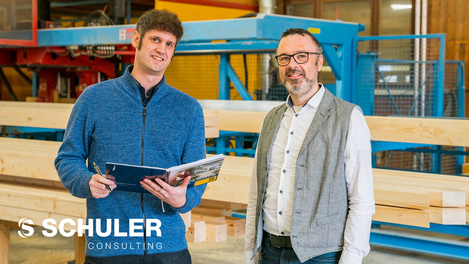Unleash the full potential of production — application-related production optimization from the WEINMANN Academy
From carpentry businesses to manufacturers of prefabricated houses, a multitude of timber construction companies have already been won over by innovative WEINMANN solutions that can cover the entire process chain from beam processing to element production.
An optimally adjusted machine is crucial for efficient production. But what happens if the customer neglects certain factors and parameters of their machine years after initial acceptance and does not continuously adapt these to their current products? One frequent consequence of this is inefficiencies creeping into production and related activities. This is where the application-related production optimization service provided by the WEINMANN Academy comes into play to identify potential for improvement and create an optimal production environment.
Dr. Sonja Engelhart, Head of the WEINMANN Academy, and application engineer Christoph Schroth, Team Leader Global Customer Qualification, talk about frequent errors, optimized work paths and other factors
The first steps in production begin in work preparation. This is where the CAD drawings of the construction project are first created, which are then forwarded to production. Christoph, over the past few years you have visited the premises of many existing customers — as an application engineer, what factors have you observed in our customers' work preparation that can lead to a reduction in production efficiency?
Christoph Schroth (CS): Work preparation plays a key role in automated production. Information about the materials and tools used, panel layers, indices, panel assignments, clamp spacing and blocked areas are specified here, as well as the processing and overcut or undercut strategy. The amount of information that is also on the plans can quickly lead to errors. In addition, I often see customers using very small plans generated from the CAD program with the maximum amount of information included. Unfortunately, this leads to the plans becoming unclear and important information being lost as a result. However, if the layers that are to be applied to an element are shown offset instead of on top of one another, processing information is displayed clearly and comprehensibly. If all information about a wall element is only implemented in a small A4 plan, colleagues in production often have no chance of determining the relevant layer and which details need to be taken into account.
Could you use a specific example to explain what consequences this could have?
CS: Production staff may misinterpret plans. Instead of the intended OSB panel, a fiberboard panel, for example, is then positioned. If the employee on the machine notices this error when starting the data record, they then have to remove the entire layer of positioned panels and lay the correct panels. If the plan is clearly designed in advance, this additional work step is not necessary. In this example alone, we can easily be talking about additional time of half to three quarters of an hour.
Unfortunately, such incidents can also add up and delay the production process. How important is work preparation for efficient production?
CS: Work preparation is of great importance not only with regard to production, but also for the processes on the construction site. A shortfall of ten minutes in work preparation, for example due to time pressure or capacity bottlenecks, can mean an additional effort of two to three hours afterward. It is therefore worth working particularly precisely and carefully during work preparation to avoid errors later in production.
Work on the machine begins after work preparation. First, the data record is read in and an NC program is created. If the machine is ready for production, the data records can be produced. But here too, inefficiencies that disrupt the production flow can arise over time. Which triggers can be considered?
CS: Various influencing factors are crucial here. This can be, for example, a further development of the products, or changed requirements for them. If something has changed in the size or type of materials used, this can also have a major impact on the efficiency of production. In addition, factors such as personnel changes or minor technical defects can lead to a loss of efficiency.
What actions do the experts from the WEINMANN Academy take to identify these described disruptive factors?
CS: On the one hand, we check the parameters of the subprograms and the tool databases as well as the machine hardware. On the other hand, we also assess whether the selected machining strategy is optimal and whether the correct tools and parameters are used for this purpose. However, the qualification of the employees is another aspect that must be taken into account on site in order to identify the negative influencing factors that could disrupt the production flow.
What potential for improvement do you most often notice among customers?
CS: Often our customers start production with just one product. However, companies and their plant technology grow over the years, which also sees the elements and products change. We are finding time and again that gypsum materials are increasingly being used in addition to wood materials. However, if the same tools are used for plasterboard processing as for wood processing, the tool has a poor service life and it must be considered whether the tool should be adapted for use with abrasive materials. The correct tools are essential to keep machine downtimes to a minimum. In 80% of customers, we can already find potential for improvement in this area in the first ten minutes.
In your opinion, what increase in throughput can be achieved for the customer if work is carried out more efficiently both in work preparation and on the machine, and if the potential we have identified is exploited?
CS: For most customers I have looked after in the past, we have been able to increase efficiency by 10 to 20%.
The final area of focus in terms of application-related production optimization is assessing production processes and the production environment. What influential factors are checked here and, in your experience, where is there most commonly potential for optimization in practice?
CS: In this phase, the material quality and the material flow are assessed in particular. Together, we ask ourselves whether the material provision routes and the working paths taken by the operating personnel are efficient. Generally speaking, however, the working environment and the data flow are also taken into account. In practice, we often find that consumables and tools are positioned arbitrarily after delivery of the machine. After a few weeks, staff get used to the routes and material positions that have been created. However, in most cases, no time has been taken to consider whether the work routes in place are sensible. The same applies to the positioning of the production materials in the warehouse and warehouse logistics in general.
The potential for optimization found is unique and varies hugely from customer to customer. How do the WEINMANN experts document this potential?
CS: For lasting documentation, we use an assessment sheet in which our observations are documented using keywords. If necessary, images of specific situations are also taken make it easier to explain. At the end of the on-site visit, the documentation is discussed with the production manager(s). The customer will receive a detailed report, including the course of action that we have recommended. Minor optimizations, such as parameter settings on the machine, are made directly on site and noted in the documentation.
Overall, the process for analyzing the current situation is very extensive — how long do application engineers spend at the customer's premises on average?
CS: The exact duration heavily depends on the size of the machine pool or scale of production, as well as the type of machines. If we're talking about just one carpentry machine, it can be expected to take around one working day. As part of element production, the entire analysis can take two to three working days.
What financial considerations do customers need to take into account when implementing the recommended actions?
CS: Many optimizations are fundamentally free of charge for the customer. These are often minor reorganizations within the company. They can be optimized communication or shorter routes, for example, the implementation of which requires at most the buy-in from the company's workforce. However, other efficiency-enhancing measures do require a financial investment — for example, if a new rack contributes to the optimization of the warehouse and an accelerated material flow. In this instance, the customer must weigh up individually whether they wish to take up our recommended course of action.











